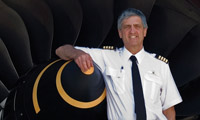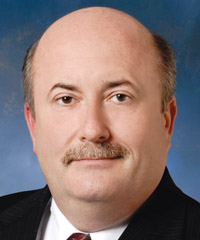Cover Story
October 1st 2012
Air safety professionals are becoming increasingly alarmed that current pilot training processes are so outdated they are failing to equip crew to cope with the complex, computer-based technology of modern jet aircraft
PILOT TRAINING 'OUTDATED' Read More »
 |
| Hero and “old school” captain, Richard de Crespigny: brought the crippled Qantas A380 into land safely. A pilot’s job is to know their plane, he said |
Major aircraft manufacturers are in the process of reviewing pilot training procedures as evidence mounts that several major accidents and incidents have been the result of cockpit crew failure to cope with the advanced automation and computer systems on new generation jets.
Ongoing assessments of improvements in training is the focus of leading air safety professionals, who are increasing their calls for enhanced global pilot training standards and a total revamp of training procedures.
Bill Voss, chief executive of the Washington-based Flight Safety Foundation (FSF) told a U.S. Senate subcommittee on aviation operations, safety and security that pilot training was “dangerously outdated”.
And John Bent, a former Cathay Pacific Airways captain, now a consultant and board member of the Professional Aviation Board of Certification, told a safety seminar in Ho Chi Minh City last month that automation had reduced the frequency and need for past piloting skills in a complex aviation system.
“It can’t train for everything. So the 60-year-old inventory-based, hours-prescriptive, box-ticking training formula will not properly address these new needs. Because we do not know everything that will happen, we cannot train for it all, but we must prepare,” he said.
Demands for a radical revision of training procedures have intensified in the past few years following a number of serious accidents. The worst, the crash of Air France 447 in the Atlantic on a flight from Rio de Janeiro to Paris, with the loss of 228 passengers and crew, was particularly unnerving for the industry.
It took two years to recover the black box from the ocean floor, but the information still could confirm the pilots had made inappropriate responses to a loss of automation. It was clear from the pilots’ dialogue that they had no idea what was happening to their aircraft until it was too late.
 |
| 'Five years ago we passed the point where automation was there to back up pilots. Clearly today, the pilot is there to be the backup to the automation' |
| Bill Voss Chief Executive Flight Safety Foundation |
Worse, one of the pilots was responding entirely inappropriately to a stall condition by pulling back on the stick rather than pushing forward, despite stall warning indications in the cockpit.
The issue was also highlighted in November 2010 with the dramatic events that occurred after a Qantas A380 flight, QF32, departed from Singapore. One of its Rolls-Royce engines exploded, sending shrapnel ripping through the wing and fuselage and cutting more than 600 wires.
The aircraft’s ECAM (Electronic Centralised Aircraft Monitor) identified some 100 significant faults and checklists to be processed by the crew. Fortunately, there were five experienced pilots on board, led by Capt. Richard de Crespigny. They eventually managed to land the plane safely in Singapore.
“The training emphasis must change,” said Bent. “Sometimes procedures and checklists may not be enough. With the Qantas incident and others, what happened on board are all things that aren’t in the book. These are all things that we need pilots to understand. We need to train them for the unexpected, which is looking at things in a different way.”
At the Asia Pacific Aviation Safety Seminar (APASS) in Vietnam last month, organized by the Association of Asia Pacific Airlines (AAPA), Airbus’ regional senior director south and southeast Asia, Michel Menestrot, said the European manufacturer was evaluating improvements for better training.
“One of the things you will see in the near future with the Airbus A350 entry into service is that we will put a little bit more emphasis on understanding the aircraft rather than learning it. Basically, the complexity of the aircraft is such now that you can’t really learn everything. What you want to do is to understand how it goes.”
The director of aviation safety at Boeing, Corky Townsend, told the same seminar the U.S. planemaker was also looking at different kinds of training.
“One of the things we have noted is the kinds of training we have had in the past probably won’t do as well going forward. So we are shifting some of our methods of how we train and we have been doing some surveys to understand how different sorts of training are received by different generations,” he said.
Boeing’s lead research scientist, Barabara Holder, earlier this year released a study of airline pilot perceptions of training and its effectiveness. She found pilots take much longer than assumed by manufacturers and airlines to become comfortable with operating a new flight management system (FMS).
| 'One of the things we have noted is the kinds of training we have had in the past probably won’t do as well going forward' |
| Corky Townsend Director of Aviation Safety Boeing |
The study found 63% of pilots struggle to manage the FMS on a new aircraft type until they have been operating it on the line for between three and six months.
More than 40% of pilots said that most of the FMS training they receive is done while flying the line, the implication being that the FMS training pilots complete on their type-rating work-up is inadequate.
Holder also noted there is no standardization among aircraft manufacturers, avionics manufacturers, airlines or the regulators on how FMS training should be delivered, concluding FMS training had to be radically reappraised.
“We are looking at that and trying to appraise different forms of providing training, as well as shifting from largely rote training to more situational training so pilots have a better, broader understanding,” said Townsend.
“We can’t just have more so we have to figure out how to do better with what we’ve got. By doing training with various scenarios we believe you get a much better learning than just having the traditional engine cut and responding to it. Everybody knows you are probably never going to get an engine cut.”
Airbus’ Menestrot also talked about a changed approach, suggesting a type-rating course might be done in a way similar to how people handle new technology in everyday life.
“When we get a new electronic device nobody is looking at the manual. You are learning by trying,” he said. “You take the device and you start punching the buttons. So, in the training we are trying to make this kind of learning available through external devices and computer-based programmes.
“People learn in a way that they are using every day. I have two young daughters and I can tell the way they play with computers and the way they learn things is completely different from my experience. At Airbus we are trying to identify these new ways of learning and insert it into training material.”
 |
| 'With requirements for a million pilots and engineers [worldwide in the next two decades] the problem really is: can we maintain quality processes with this level of growth?' |
| John Bent Board Member Professional Aviation Board of Certification |
Concerns about the ability of pilots to handle the complex automation of new generation jets such as the A380, the B787 and soon-to-arrive models such as the A350 are widespread.
As FSF’s Voss puts it: “Five years ago we passed the point where automation was there to back up pilots. Clearly today, the pilot is there to be the backup to the automation.
“This is simply a realistic assessment of the world today, except we are not training pilots to be backups to automation. We have to own up to the fact that we need to develop new kinds of pilot training.”
He added that pilots too often lose the mental picture of the aircraft’s automation. “If pilots have no idea what automation should be doing, they also have no idea if everything they observe on the panel represents a normal operation.
“That’s what happened to Air France 447. This is not just about better stick and rudder skills though … what you die from is not understanding what configuration will keep the aircraft in the air safely,” said Voss.
Bent, also speaking at the Vietnam safety seminar, said mitigation of accidents caused by human factors remains the industry’s major challenge.
He warned that the massive projected growth of aviation in the Asia-Pacific would be a factor, with 530,000 new pilots and engineers required in the next two decades. The figure worldwide is one million.
“Probably the greatest risk is the growth pressure in this region of the world. Airline safety benefits from generation three and four aircraft and many safety advances have been made, but the personnel supply threats exist and are quite serious,” said Bent.
“First of all, with growth of this level we have a quality issue. With these requirements for a million pilots and engineers [worldwide] the problem really is: can we maintain quality processes with this level of growth?”
There is a lack of global standards in training policy and supply and an element of change resistance, said Bent.
“As an airline, would you buy an airliner without a quality process? No. Do we demand a global standard of SMS (Safety Management System)? Yes. Do we accept sub-optimal personnel selection and training processes without the enforcement of one broad global standard? We do. We accept people from all over the world from different training systems and different levels of quality process,” he said.
“Upgraded selection (of pilot candidates) is absolutely vital. We’ve got different generational perspectives coming into the industry so we need to understand how we can select these new generations in a way that is valid. We need upgraded training that is much more relevant and quality controlled. It must not be frozen in concrete for another 60 years as the commercial pilot’s licence was.”
That is a widely shared view. The international Guild of Air Pilots, in a position paper, suggested that pilot selection methods be kept under constant review to accommodate the new skill requirements brought about by automation.
It recognized that manufacturers have done a great deal to address the way in which automated systems are operated by pilots, but emphasized the need to ensure future flight deck design must enable a competent crew to function adequately and without confusion throughout the operating regime, including abnormal conditions.
The guild said there was “positive evidence that some pilots are not being trained to a level that enables them to understand adequately not just how the automated systems work, but how to use them to best advantage in all circumstances – and when to discard the automatics and revert to manual control”.
It also believed regulatory authorities and operators must remain constantly aware of continuing developments in automation and be prepared to legislate and operate accordingly.
The industry is not ignoring the problem. ICAO and IATA have been working closely on pilot training issues and IATA has an ongoing Training and Qualification Initiative (ITQI) programme which covers such things as EBT (Evidence Based Training), Multi-Crew Pilot License (MPL), Pilot Aptitude Testing (PAT), Instructor Qualification (IQ), Flight Simulation Training Devices (FSTD) and Engineering and Maintenance (E&M).
It arose from an industry-wide consensus that, in order to reduce accident rates, a strategic review of recurrent and type-rating training for airline pilots was necessary.
“Over time, aircraft design and reliability has improved significantly, yet accidents still occur, even though the aircraft and systems are operating without malfunction. Controlled Flight into Terrain (CFIT) is one example of this principle, where inadequate situational awareness on the part of the crew is almost always a contributing factor,” said IATA.
“It is impossible to foresee all plausible accident scenarios in today’s complex, yet highly reliable, aviation system and the circumstances of the next accident are difficult to predict.
“EBT addresses this by prioritizing the development and assessment of key competencies. Scenario-based training is recommended within an EBT programme, but the scenarios are simply a vehicle and means to develop and evaluate competence.
“Mastering a finite number of key competencies will allow pilots to manage an unlimited number of potentially dangerous situations in flight operations.”
Despite all this, globally standardized pilot training procedures are likely a long way off. In the meantime, many flying schools have added cells to their training courses that cover coping with the unexpected in the cockpit, the so-called “startle effect”.
One pilot who did successfully deal with it was Qantas Capt. Richard de Crespigny. How? As he explained in his book about the incident, QF32: “I’m old school in this respect. On board, I believe the pilot’s job is exactly as written in the federal laws; pilots are ‘responsible for the safety of the passengers and crew’ regardless of what stands between them and disaster.
“Whether it’s a fly-by-wire computer or a few cables connected to your rudder pedals, your job is to know your plane, be unafraid of the plane and to fly the plane.”